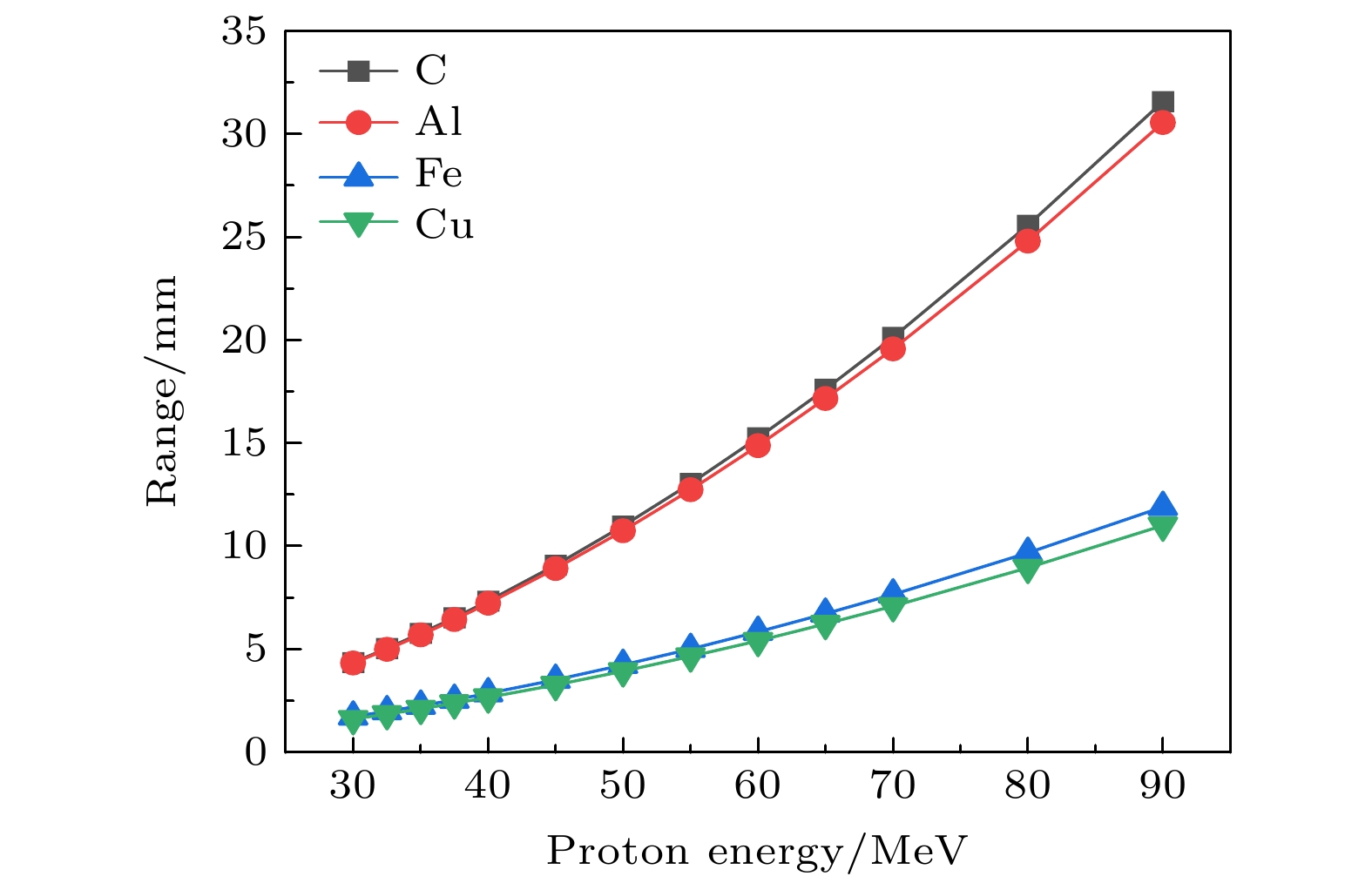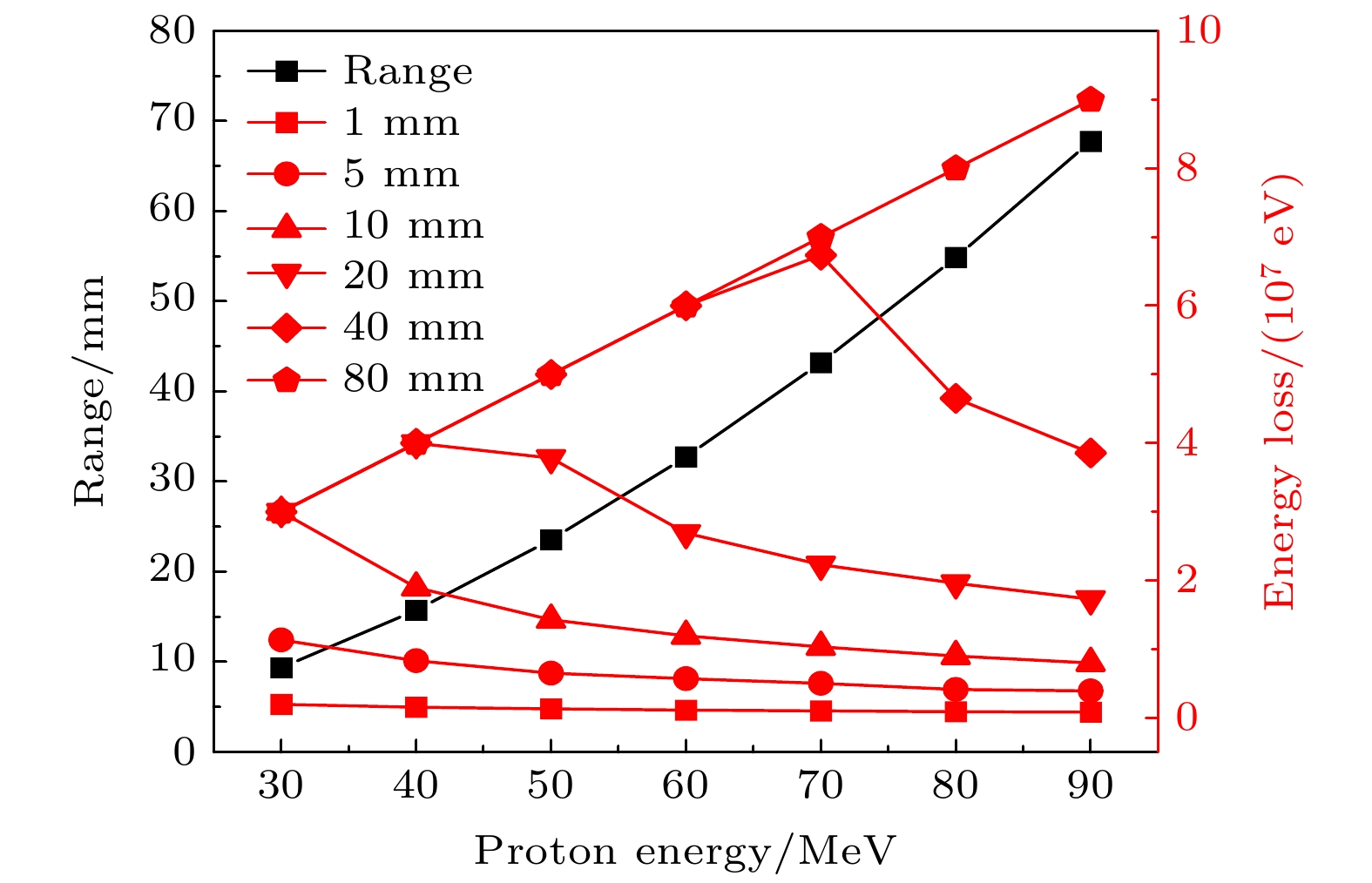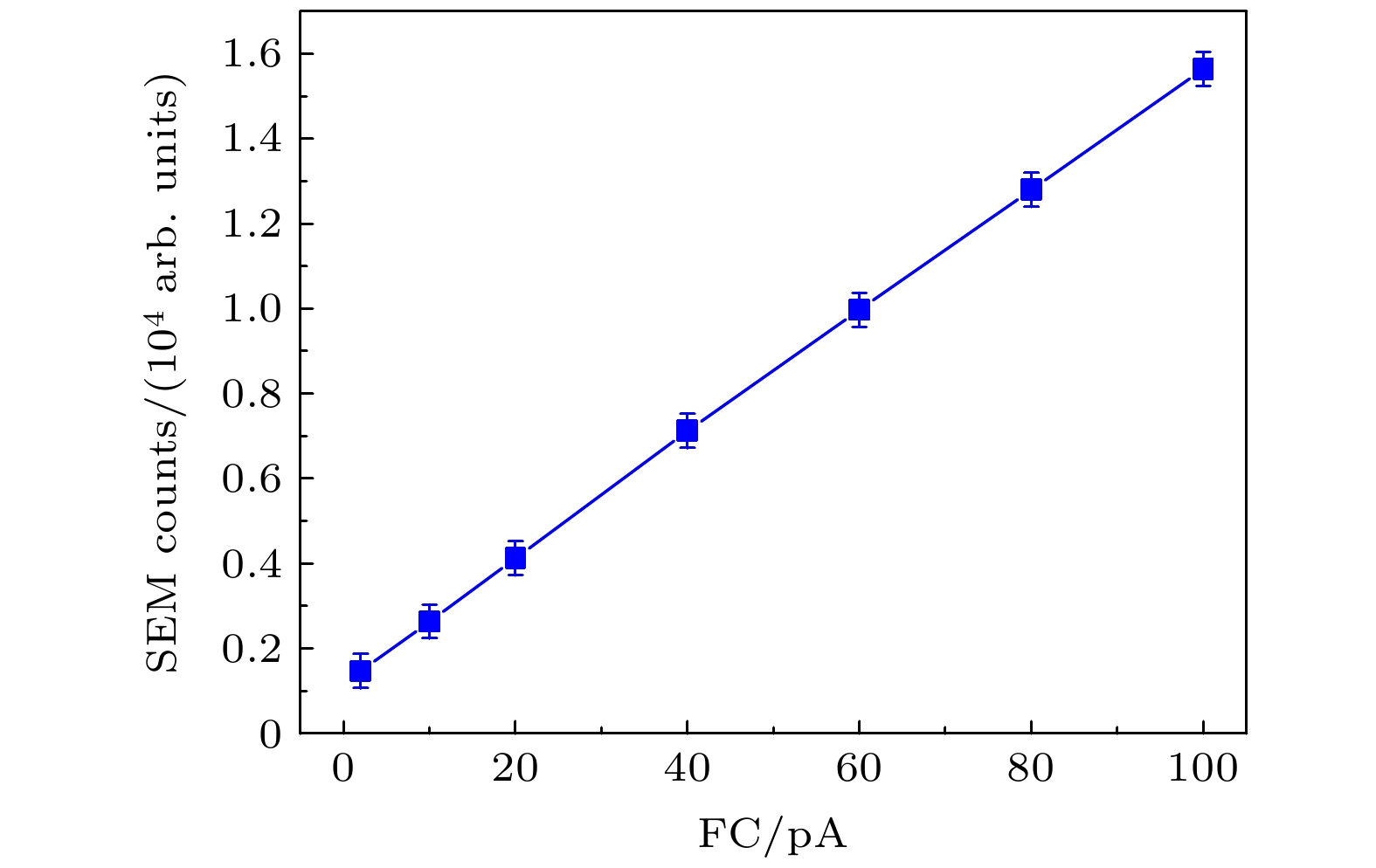-
质子是太空辐射环境中的主要粒子成分, 随着半导体工艺向着小尺寸高集成度方向不断发展, 质子单粒子效应不容忽视. 通过加速器模拟空间辐射进行地面实验是评价质子单粒子效应最重要的手段, 质子注量率的准确测量是器件考核评估过程中最关键的环节. 本文基于原子能院100MeV质子单粒子效应辐照装置, 突破了宽量程中能质子注量率测量技术, 开发了法拉第筒、塑料闪烁体探测器和二次电子发射监督器等探测工具, 可以对束流进行宽量程范围准确测量, 解决了质子注量率在106—107 p·cm–2·s–1范围内难以测量的关键难题, 并进行了注量率不确定度的分析研究, 同一注量率下法拉第筒和塑料闪烁体探测器的实验测量误差与理论分析误差相符. 对中能质子注量率测量达到了国际同类装置水平. 该研究建立的中能质子注量率测量系统和不确定度分析方法, 为准确评估元器件辐射效应奠定了基础.
Proton is the main particle component in the space radiation environment. The proton single event effect cannot be ignored with the continuous development of semiconductor technology. Accelerator simulation is the most important method to evaluate the single event effect caused by proton radiation, and the accurate measurement of proton flux is the most critical aspect in the device evaluation process. The research is based on the 100 MeV proton single-event irradiation device of the Atomic Energy Institute, which breaks through the wide-range mid-energy proton fluence rate measurement technology. The detection tools are developed such as Faraday cup, plastic scintillator detectors and secondary electron emission monitors, which can be used for measuring the proton beam current in a wide range. Faraday cup and plastic scintillator detector can be used for measuring the high flux proton and the low flux proton, respectively. Secondary electron emission monitor can be used for conducting the online real-time measurement. The proton fluxes in a range of 106– 107 p·cm–2·s–1 are measured by using two separate detectors. The analysis of the fluence rate uncertainty is carried out. The uncertainty of measurement results mainly include three aspects: measurement method, measuring instrument and equipment, and repeatability of multiple measurement results. Here in this work, the Faraday cup is taken for example to analyze the uncertainty sources in the proton flux measurement. The measurement methods include the calculation of the collection efficiency of the Faraday cup (collection efficiency + escape rate = 1) and the calculation method of flux (flux = current/collection area). For the measuring instruments and equipment, mainly including 6517A and other electronic devices, their errors are determined by the accuracies of the instruments themselves. Repeatability of multiple measurement results mainly from the error caused by the instability of the accelerator beam output, the error caused by randomness of multiple measurement results, and the error given by the statistical method. The analysis shows that the uncertainty of flux measurement by Faraday cup is 7.26%, and the uncertainty of flux measurement by plastic scintillator detector is 1.64%. The flux measurement of the proton fluence rate has reached the level of similar devices in the world, filling the gap in this field in China. It has a certain reference and guiding significance for the follow-up study of medium- and high-energy proton beam measurement in China. The mid-energy proton flux measurement system and uncertainty analysis method established in this study lay the foundation for accurately evaluating the component radiation effects. -
Keywords:
- medium energy proton /
- flux measurement /
- beam detectors /
- uncertainty analysis
[1] Sawyer D M, Vette J I 1976 National Space Science Data Center Report NSSDC/WDC-A-R&S 76-06, NASA-GSFC TMS-72605
[2] Heidel D F, Rodbell K P, Oldiges P, Gordon M S, Tang H H K, Cannon E H Plettner C 2006 IEEE Trans. Nucl. Sci. 53 3512
 Google Scholar
Google Scholar
[3] Bendel W L, Petersen E L 1983 IEEE Trans. Nucl. Sci. 30 4481
 Google Scholar
Google Scholar
[4] Ikeda N, Kuboyama S, Matsuda S, Handa T 2005 IEEE Trans. Nucl. Sci. 52 2200
 Google Scholar
Google Scholar
[5] Caron P, Inguimbert C, Artola L, Ecoffet R, Bezerra F 2019 IEEE Trans. Nucl. Sci. 66 1404
 Google Scholar
Google Scholar
[6] Von Przewoski B, Rinckel T, Manwaring W, Broxton G 2004 Radiation Effects Data Workshop 851 145
[7] Hajdas W, Adams L, Nickson B, Zehnder A 1996 Nucl. Instrum. Methods B 113 54
 Google Scholar
Google Scholar
[8] Blackmore E 2000 IEEE Radiation Effects Data Workshop Rec. Reno, Nevada, USA, 2000 p1
[9] 罗尹虹, 张 凤祁, 王燕萍, 王圆明, 郭晓强, 郭红霞 2016 物理学报 65 068501
 Google Scholar
Google Scholar
Luo Y H, Zhang F Q, Wang Y P, Wang Y M, Guo X Q, Guo H X 2016 Acta Phys. Sin. 65 068501
 Google Scholar
Google Scholar
[10] 何安林, 郭 刚, 陈力, 沈东军, 任义, 刘建成, 张志超, 蔡莉, 史淑廷, 王惠, 范辉, 高丽娟, 孔福全 2014 原子能科学技术 48 2364
 Google Scholar
Google Scholar
He A L, Guo G, Chen L, Shen D J, Ren Y, Liu J C, Zhang ZC, Cai L, Shi S T, Wang H, Fan H, Gao L J, Kong F Q 2014 Atom. Energ. Sci. Technol. 48 2364
 Google Scholar
Google Scholar
[11] 杨海亮, 李国政, 李原春, 姜景和, 贺朝会, 唐本奇 2001 原子能科学技术 35 490
 Google Scholar
Google Scholar
Yang H L, Li G Z, Li Y C, Jiang J H, He C H, Tang B Q 2001 Atom. Energ. Sci. Technol. 35 490
 Google Scholar
Google Scholar
[12] 韩金华, 郭刚, 刘建成, 隋丽, 孔福全, 肖舒颜, 覃英参, 张艳文 2019 物理学报 68 054104
 Google Scholar
Google Scholar
Han J H, Guo G, Liu J C, Sui L, Kong F Q, Xiao S Y, Qin Y C, Zhang Y W 2019 Acta Phys. Sin. 68 054104
 Google Scholar
Google Scholar
[13] 韩金华, 覃英参, 郭刚, 张艳文, 2020 物理学报 69 033401
 Google Scholar
Google Scholar
Han J H, Qin Y C, Guo G, Zhang Y W 2020 Acta Phys. Sin. 69 033401
 Google Scholar
Google Scholar
[14] Strehl P 2006 Beam Instrumentation and Diagnostics (Heidelberg: Springer-Verlag) pp1−438
[15] Pages L, Bertel E, Joffre H, Sklavenitis L 1927 At. Data Nucl. Data Tables 4 1
[16] 郭忠言, 肖国青, 詹文龙, 徐瑚珊, 孙志宇, 李加兴, 王猛, 陈志强, 毛瑞士, 王武生, 白洁, 胡正国, 陈立新, 李琛 2003 高能物理与核物理 27 158
 Google Scholar
Google Scholar
Guo Z Y, Xiao G Q, Zhan W L, Xu H S, Sun Z Y, Li J X, Wang M, Chen Z Q, Mao R, S, Wang W S, Bai J, Hu Z G, Chen L X, Li C 2003 High Energy Phys. Nucl. 27 158
 Google Scholar
Google Scholar
[17] Johnson M B, McMahan M A, Gimpel T L, Tiffany W S 2006 Proceedings of the 2006 IEEE Radiation Effects Data Workshop Ponte Verdra Beach, Florida, USA 2006 p183
[18] Murray K M, Stapor W J, Casteneda C 1989 Nucl. Instrum. Methods A 281 616
 Google Scholar
Google Scholar
[19] Castaneda C M 2001 Proceedings of the 2001 IEEE Radiation Effects Data Workshop Vancouver, Canada 2001 p77
[20] Blackmore E W 2003 Proceedings of the 2003 IEEE Radiation Effects Data Workshop Monterey, California, USA 2003 p149
[21] Przewoski B V, Rinckel T, Manwaring W, Broxton G, Chipara M, Ellis T, Hall E R, Kinser A 2004 Proceedings of the 2004 IEEE Radiation Effects Data Workshop Atlanta, Georiga, USA 2004 p145
-
-
[1] Sawyer D M, Vette J I 1976 National Space Science Data Center Report NSSDC/WDC-A-R&S 76-06, NASA-GSFC TMS-72605
[2] Heidel D F, Rodbell K P, Oldiges P, Gordon M S, Tang H H K, Cannon E H Plettner C 2006 IEEE Trans. Nucl. Sci. 53 3512
 Google Scholar
Google Scholar
[3] Bendel W L, Petersen E L 1983 IEEE Trans. Nucl. Sci. 30 4481
 Google Scholar
Google Scholar
[4] Ikeda N, Kuboyama S, Matsuda S, Handa T 2005 IEEE Trans. Nucl. Sci. 52 2200
 Google Scholar
Google Scholar
[5] Caron P, Inguimbert C, Artola L, Ecoffet R, Bezerra F 2019 IEEE Trans. Nucl. Sci. 66 1404
 Google Scholar
Google Scholar
[6] Von Przewoski B, Rinckel T, Manwaring W, Broxton G 2004 Radiation Effects Data Workshop 851 145
[7] Hajdas W, Adams L, Nickson B, Zehnder A 1996 Nucl. Instrum. Methods B 113 54
 Google Scholar
Google Scholar
[8] Blackmore E 2000 IEEE Radiation Effects Data Workshop Rec. Reno, Nevada, USA, 2000 p1
[9] 罗尹虹, 张 凤祁, 王燕萍, 王圆明, 郭晓强, 郭红霞 2016 物理学报 65 068501
 Google Scholar
Google Scholar
Luo Y H, Zhang F Q, Wang Y P, Wang Y M, Guo X Q, Guo H X 2016 Acta Phys. Sin. 65 068501
 Google Scholar
Google Scholar
[10] 何安林, 郭 刚, 陈力, 沈东军, 任义, 刘建成, 张志超, 蔡莉, 史淑廷, 王惠, 范辉, 高丽娟, 孔福全 2014 原子能科学技术 48 2364
 Google Scholar
Google Scholar
He A L, Guo G, Chen L, Shen D J, Ren Y, Liu J C, Zhang ZC, Cai L, Shi S T, Wang H, Fan H, Gao L J, Kong F Q 2014 Atom. Energ. Sci. Technol. 48 2364
 Google Scholar
Google Scholar
[11] 杨海亮, 李国政, 李原春, 姜景和, 贺朝会, 唐本奇 2001 原子能科学技术 35 490
 Google Scholar
Google Scholar
Yang H L, Li G Z, Li Y C, Jiang J H, He C H, Tang B Q 2001 Atom. Energ. Sci. Technol. 35 490
 Google Scholar
Google Scholar
[12] 韩金华, 郭刚, 刘建成, 隋丽, 孔福全, 肖舒颜, 覃英参, 张艳文 2019 物理学报 68 054104
 Google Scholar
Google Scholar
Han J H, Guo G, Liu J C, Sui L, Kong F Q, Xiao S Y, Qin Y C, Zhang Y W 2019 Acta Phys. Sin. 68 054104
 Google Scholar
Google Scholar
[13] 韩金华, 覃英参, 郭刚, 张艳文, 2020 物理学报 69 033401
 Google Scholar
Google Scholar
Han J H, Qin Y C, Guo G, Zhang Y W 2020 Acta Phys. Sin. 69 033401
 Google Scholar
Google Scholar
[14] Strehl P 2006 Beam Instrumentation and Diagnostics (Heidelberg: Springer-Verlag) pp1−438
[15] Pages L, Bertel E, Joffre H, Sklavenitis L 1927 At. Data Nucl. Data Tables 4 1
[16] 郭忠言, 肖国青, 詹文龙, 徐瑚珊, 孙志宇, 李加兴, 王猛, 陈志强, 毛瑞士, 王武生, 白洁, 胡正国, 陈立新, 李琛 2003 高能物理与核物理 27 158
 Google Scholar
Google Scholar
Guo Z Y, Xiao G Q, Zhan W L, Xu H S, Sun Z Y, Li J X, Wang M, Chen Z Q, Mao R, S, Wang W S, Bai J, Hu Z G, Chen L X, Li C 2003 High Energy Phys. Nucl. 27 158
 Google Scholar
Google Scholar
[17] Johnson M B, McMahan M A, Gimpel T L, Tiffany W S 2006 Proceedings of the 2006 IEEE Radiation Effects Data Workshop Ponte Verdra Beach, Florida, USA 2006 p183
[18] Murray K M, Stapor W J, Casteneda C 1989 Nucl. Instrum. Methods A 281 616
 Google Scholar
Google Scholar
[19] Castaneda C M 2001 Proceedings of the 2001 IEEE Radiation Effects Data Workshop Vancouver, Canada 2001 p77
[20] Blackmore E W 2003 Proceedings of the 2003 IEEE Radiation Effects Data Workshop Monterey, California, USA 2003 p149
[21] Przewoski B V, Rinckel T, Manwaring W, Broxton G, Chipara M, Ellis T, Hall E R, Kinser A 2004 Proceedings of the 2004 IEEE Radiation Effects Data Workshop Atlanta, Georiga, USA 2004 p145
计量
- 文章访问数: 9672
- PDF下载量: 135
- 被引次数: 0














 下载:
下载:







